I recently acquired a 'failed' GM 5L40-E transmission,which is used in the '02-'06MY 3.0 litre diesel models, so I thought I'd do a similar write-up for that transmission too.
My particular transmission was reported as having lost reverse gear. It should be said that the 5L40-E transmission is notorious for failing at between 80,000 and 100,000 miles in the Range Rover.
Anyway, here we go.....
Starting at the bottom, first off is the sump pan (20-off10mm A/F bolts) and the metal & rubber gasket :


As soon as the sump pan came off it was clear that something was amiss - it looked like there'd been an explosion in a glitter factory! Everything was covered in fine metallic debris :

The filter comes off easily (just pull)

Note that the filter has a spacer and two seals.
Like with the ZF boxes the 'correct' filter is made by Filtran in Germany (the German border is only a few yards away from where the GM transmissions are built in Strasbourg, France).
The wiring harness comes out next :


…followed by the valve block assembly. This is retained by nine screws – one with a 10mm A/F head and the remainder requiring a Torx E8 socket

Interesting to see that GM put the inhibitor (or XYZ) switch inside the transmission rather than on the outside like ZF.
Here's the valve block assembly from underneath :
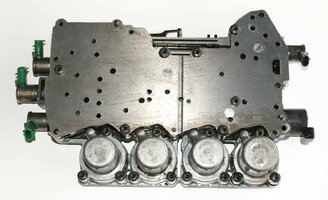
The five solenoids can clearly be seen as well as the four accumulators :

The three (identical) solenoids with the green connectors are the shift solenoids for the 1-2, 2-3 & 4-5 shifts (labelled A, B & C respectivelyin the casting).
The similar sized solenoid at the other end of the block assembly, with the grey connector, operates the torque converter lock-up clutch.
The remaining (large) solenoid is the pressure control solenoid whose job it is to adjust the transmission's line pressure.
I did a quick check of all five solenoids' winding resistances and all were to spec. (at 20 deg. C. these should be : Shift solenoids = 15 to 17 Ohms, TCC solenoid = 10.0 to 11.5 Ohms and pressure control solenoid = 3.5 to 4.6 Ohms)
The two speed sensors can then be removed (each held in with a single screw) :

The sensors should have a resistance between 325 and 485 Ohms at 20 deg. C. Mine measured 387 and 389 Ohms.
The jump tubes that feed fluid from the valve block to the clutches in the casing can then be removed (they're held together by metal straps) :


Okay, moving around to the front of the transmission now ……
Just before removing the bellhousing I removed the torque converter turbine shaft O-ring :
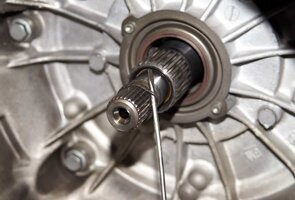
Then the seven 13mm A/F bolts which secure the bellhousing to the maincase follow :

The bellhousing can then be drawn off. The oil pump cover assembly is bolted to the back of the bellhousing :

The running gear can now be extracted :

first the direct and reverse clutch assembly :

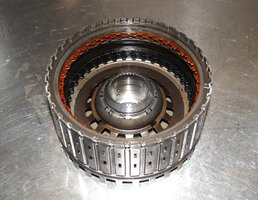
followed by the forward and coast clutch assembly (attached to the input shaft):


Hmmm, something wrong here! The input sun gear shaft and forward clutch sprag assembly comes with it and doesn't want to part company with the forward and coast clutch assembly :

and clearly something has been getting a bit hot!
With some effort I finally extract the input sun gear shaft and the forward clutch hub/sprag assembly has also obviously been getting very hot :

Removing the plates from the forward clutch :
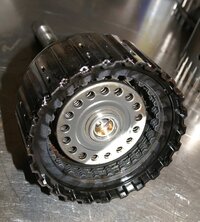
and, well, they are toast :
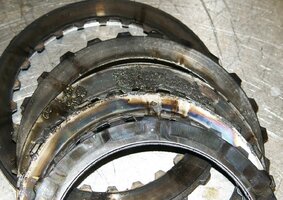
There's nothing left of the friction material and several of the plates have friction welded themselves together.
Next out is the direct clutch hub & shaft assembly :



and then the overdrive and reverse clutch hub which has the intermediate clutch sprag assembly attached :

The next stage involves the removal of this huge circlip - which I've highlighted in red for clarity :

This requires a seriously large pair of circlip pliers

The retainer ring is selective i.e. it's available in different thicknesses to cater for the particular tolerance stack up.
The intermediate & overdrive clutch assembly then pulls out :

followed by the low clutch sprag assembly and its thrust washer :

The centre support assembly can then be extracted from the casing :

This centre support assembly includes the low/reverse clutch, second clutch and second coast clutch
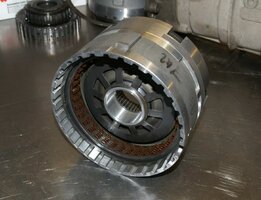

Then the planetary carrier assembly can be removed :


Leaving the rear internal gear/output shaft in the casing (you can see the park lock teeth around the outside of the internal gear)
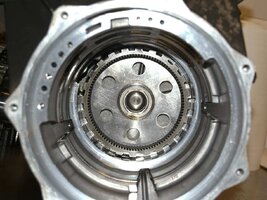
Now switching attention to the rear of the transmission.....

The rear casing is removed (7-off M13 A/F bolts) :

to gain access to the output shaft assembly :
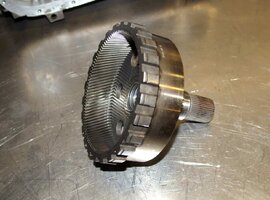
and the park lock engagement mechanism :

which just leaves the selector shaft assembly :

So having removed these last few components :

finally leaves an empty casing :

Regarding all the metallic debris that was found inside the transmission, clearly the failed clutch plates will have contributed but they can't have been solely responsible for the huge quantity of debris discovered so I needed to dig a bit deeper.
Here's the torque converter with the weld, which holds the two halves of its casing together, removed :

Lifting off the engine-side half of the casing reveals the torque converterlock-up clutch :
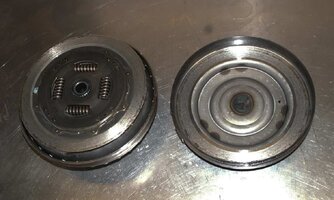
and I could immediately see that the clutch lining had disappeared completely allowing metal-to-metal contact :
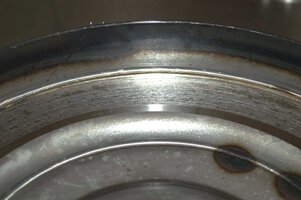

which is presumably where the majority of the metallic debris has come from.
Lifting off the lock-up clutch assembly reveals the turbine :


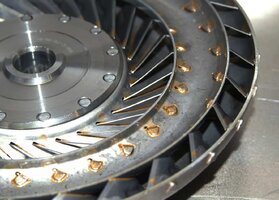
With the turbine lifted out the stator and impeller can now be seen :

The stator has an axial thrust bearing either side of it, both of which appear to be in good condition :

and removing the centre cover reveals the roller-and-ramp one-way clutch which allows the stator to back-paddle once the converter's coupling point has been reached (at around 85% speed ratio)

And finally, after removing the stator, the impeller in all its glory :


So, clearly an issue with the lock-up clutch lining but the remainder of the converter appears to be in good condition.
Anyway, I now need to strip down the sub-assemblies – especially the valve block, where I suspect I will find the root cause of the failure.......
Starting with the disassembly of the main hydraulic block.....
Working from the top side, the four accumulators are removed first. The accumulators are used as 'shock absorbers' to control the feel of each upshift - each of the four upshifts having its own accumulator for the oncoming clutch :
2nd clutch accumulator = 1-2 upshift
Intermediate clutch accumulator = 2-3 upshift
Direct clutch accumulator = 3-4 upshift
Overdrive clutch accumulator = 4-5 upshift

Each is made up of a housing, piston & spring. The ATSG manual states that all four accumulators are identical but this is clearly not the case for the L322 version of the 5L40-E. Three of the housings/pistons are identical (overdrive, intermediate and 2nd clutch) but the direct clutch accumulator has a larger diameter upper piston & therefore housing. The springs aren't all the same either. The overdrive & 2nd clutch accumulator springs are both identical but are longer (65mm measured free length) than the direct & intermediate clutch accumulator springs (60mm measured free length) which, again, appear to be both identical.
The photos show that the 2nd clutch accumulator spring was broken in my transmission, which must have affected the quality of the 1-2 upshift (I believe that this is quite a common complaint).

Interestingly this is the only spring of the four which doesn't have a central support cast into the valve block

This particular transmission has the larger diameter second & second coast clutches used in the later models of the 5L40-E :

2nd clutch plate outside diameter increased from 130mm in the early models to 138mm

2nd coast clutch plate outside diameter increased from 173mm in the early models to 176mm
Anyway, the second & second coast clutches were in fine condition :

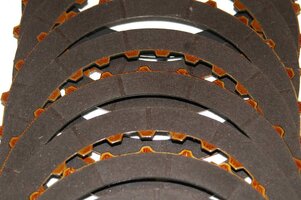


Back to the valve block, the seven Torx T30 headed screws are removed from the top channel plate
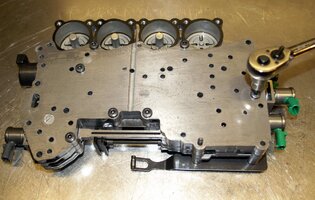
Followed by the remaining three screws (2 x Torx T30 and 1-off 10mm A/F, which bolts down the detent spring on the rear valve body) on the control valve body side

Both the control valve bodies can then be lifted away from the channel plates
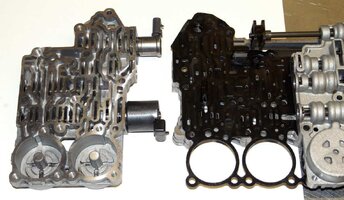

exposing the gasket which seals the control valve bodies to the spacer plate.
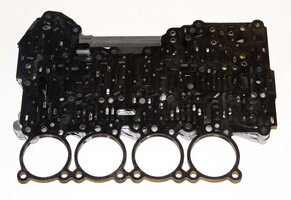
This gasket is fitted with two screens or filters. One screen is situated between the feed limit valve and the main pressure control solenoid and the other between the feed limit valve and the torque converter lock-up clutch solenoid (the feed limit valve 'caps' the pressure seen by the solenoids to prevent them being overloaded).

Considering the amount of metallic debris that I found in the fluid these filters are amazingly clean.
Once the spacer plate & gasket are removed the bottom channel plate can be seen with its twelve ball valves. Everything still looking okay so far........
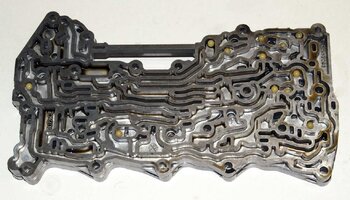
The top & bottom channel plates can then be separated (yet another gasket)

Removing the gasket leaves just the top channel plate

On the top side of the gasket an amount of metallic debris has accumulated

So, still nothing much yet to explain the failure.
Front & rear control valve bodies next..........
All the valves from the front control valve body :
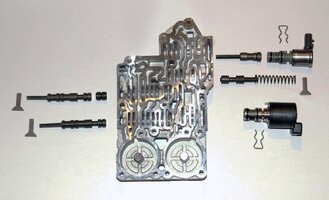
and the rear control valve body :

appear, on the face of it, to be fine from just a visual inspection – though each would need vacuum testing to properly check the wear levels.
The reverse lockout valve (2nd up from the bottom on the right in the picture above) seemed free to move. This is the spool that commonly sticks and prevents reverse gear from engaging.
Despite the levels of metallic debris in the fluid it would seem that the filter had still been doing a sterling job of keeping it away from the solenoids which showed no signs of debris around their own screens :

To check the remaining spool valves I removed the pump cover from the bellhousing :


and, again, each spool and valve assembly looks okay visually :

The main flow screen from the pump :

shows no indication that large particles of metallic debris had reached that far into the hydraulic circuit either
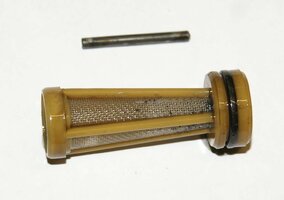
The pump itself (variable displacement vane-type) also looks in good condition:

So, in conclusion, all a bit of an anti-climax really. At the start of the teardown I was expecting to find a really obvious cause for the melted clutch packs and the torque converter lock-up clutch which had worn through its lining – maybe a stuck valve or, at the very least, something palpable to explain why the transmission had come to such a sticky end – but, in the end, nothing particularly stood out.
I would therefore certainly agree with the conclusion that Stevemfr (over on the rangerover.net forum) reached following his research on this transmission i.e. the mechanical problems are the result of reduced hydraulic pressures caused by wear & subsequent leakage in the hydraulic valve blocks. It's unfortunate that I don't have the necessary flow kit to be able to measure the valve leakages and prove this but nevertheless I think that it provides the best explanation.
As part of his research Stevemfr spoke to Sonnax - based in Bellows Falls, Vermont, USA - who produce rectification kits for the 5L40-E (as well as many other automatic transmissions) which, they claim, overcome the deficiencies of the 'soft' GM valve blocks. The diagrams below show the individual valves for which Sonnax provide a modification kit. All the spools/valves reside in one of three hydraulic blocks (i.e. front control valve body, rear control valve body and oil pump cover). The spools highlighted in green just require the existing bore to be reamed out slightly larger and then an oversized spool valve is fitted. The spools highlighted in yellow require the bores to be opened out still further so that both a new sleeve and spool can be fitted. The 'XXK' number (e.g. 04K) on the diagrams is the Sonnax kit reference for that particular valve.



To be able to carry out the re-machining of the blocks an amount of dedicated tooling is required from Sonnax. This consists of a reaming fixture and pump base plate (which can be seen in the YouTube video below) together with reamers, jigs and guide pins which are generally unique to each valve. I made enquiries regarding this kit and, all in, the total cost of this tooling is around £1375.
On top of that there is the cost of the valve kits. Each varies between around £45 and £70 depending on its complexity and, as Sonnax produce a kit for eleven out of the fifteen valves, this totals up at just under £600 for all eleven valves to be replaced.
Not, then, a job for an amateur doing a one-off overhaul - but worthwhile, I think, looking out for suppliers who will provide exchange valve blocks with the Sonnax modifications carried out.
My particular transmission was reported as having lost reverse gear. It should be said that the 5L40-E transmission is notorious for failing at between 80,000 and 100,000 miles in the Range Rover.
Anyway, here we go.....
Starting at the bottom, first off is the sump pan (20-off10mm A/F bolts) and the metal & rubber gasket :


As soon as the sump pan came off it was clear that something was amiss - it looked like there'd been an explosion in a glitter factory! Everything was covered in fine metallic debris :

The filter comes off easily (just pull)

Note that the filter has a spacer and two seals.
Like with the ZF boxes the 'correct' filter is made by Filtran in Germany (the German border is only a few yards away from where the GM transmissions are built in Strasbourg, France).
The wiring harness comes out next :


…followed by the valve block assembly. This is retained by nine screws – one with a 10mm A/F head and the remainder requiring a Torx E8 socket

Interesting to see that GM put the inhibitor (or XYZ) switch inside the transmission rather than on the outside like ZF.
Here's the valve block assembly from underneath :

The five solenoids can clearly be seen as well as the four accumulators :

The three (identical) solenoids with the green connectors are the shift solenoids for the 1-2, 2-3 & 4-5 shifts (labelled A, B & C respectivelyin the casting).
The similar sized solenoid at the other end of the block assembly, with the grey connector, operates the torque converter lock-up clutch.
The remaining (large) solenoid is the pressure control solenoid whose job it is to adjust the transmission's line pressure.
I did a quick check of all five solenoids' winding resistances and all were to spec. (at 20 deg. C. these should be : Shift solenoids = 15 to 17 Ohms, TCC solenoid = 10.0 to 11.5 Ohms and pressure control solenoid = 3.5 to 4.6 Ohms)
The two speed sensors can then be removed (each held in with a single screw) :

The sensors should have a resistance between 325 and 485 Ohms at 20 deg. C. Mine measured 387 and 389 Ohms.
The jump tubes that feed fluid from the valve block to the clutches in the casing can then be removed (they're held together by metal straps) :


Okay, moving around to the front of the transmission now ……
Just before removing the bellhousing I removed the torque converter turbine shaft O-ring :

Then the seven 13mm A/F bolts which secure the bellhousing to the maincase follow :

The bellhousing can then be drawn off. The oil pump cover assembly is bolted to the back of the bellhousing :

The running gear can now be extracted :

first the direct and reverse clutch assembly :


followed by the forward and coast clutch assembly (attached to the input shaft):


Hmmm, something wrong here! The input sun gear shaft and forward clutch sprag assembly comes with it and doesn't want to part company with the forward and coast clutch assembly :

and clearly something has been getting a bit hot!
With some effort I finally extract the input sun gear shaft and the forward clutch hub/sprag assembly has also obviously been getting very hot :

Removing the plates from the forward clutch :

and, well, they are toast :

There's nothing left of the friction material and several of the plates have friction welded themselves together.
Next out is the direct clutch hub & shaft assembly :



and then the overdrive and reverse clutch hub which has the intermediate clutch sprag assembly attached :

The next stage involves the removal of this huge circlip - which I've highlighted in red for clarity :

This requires a seriously large pair of circlip pliers

The retainer ring is selective i.e. it's available in different thicknesses to cater for the particular tolerance stack up.
The intermediate & overdrive clutch assembly then pulls out :

followed by the low clutch sprag assembly and its thrust washer :

The centre support assembly can then be extracted from the casing :

This centre support assembly includes the low/reverse clutch, second clutch and second coast clutch


Then the planetary carrier assembly can be removed :


Leaving the rear internal gear/output shaft in the casing (you can see the park lock teeth around the outside of the internal gear)

Now switching attention to the rear of the transmission.....

The rear casing is removed (7-off M13 A/F bolts) :

to gain access to the output shaft assembly :

and the park lock engagement mechanism :

which just leaves the selector shaft assembly :

So having removed these last few components :

finally leaves an empty casing :

Regarding all the metallic debris that was found inside the transmission, clearly the failed clutch plates will have contributed but they can't have been solely responsible for the huge quantity of debris discovered so I needed to dig a bit deeper.
Here's the torque converter with the weld, which holds the two halves of its casing together, removed :

Lifting off the engine-side half of the casing reveals the torque converterlock-up clutch :

and I could immediately see that the clutch lining had disappeared completely allowing metal-to-metal contact :


which is presumably where the majority of the metallic debris has come from.
Lifting off the lock-up clutch assembly reveals the turbine :



With the turbine lifted out the stator and impeller can now be seen :

The stator has an axial thrust bearing either side of it, both of which appear to be in good condition :

and removing the centre cover reveals the roller-and-ramp one-way clutch which allows the stator to back-paddle once the converter's coupling point has been reached (at around 85% speed ratio)

And finally, after removing the stator, the impeller in all its glory :


So, clearly an issue with the lock-up clutch lining but the remainder of the converter appears to be in good condition.
Anyway, I now need to strip down the sub-assemblies – especially the valve block, where I suspect I will find the root cause of the failure.......
Starting with the disassembly of the main hydraulic block.....
Working from the top side, the four accumulators are removed first. The accumulators are used as 'shock absorbers' to control the feel of each upshift - each of the four upshifts having its own accumulator for the oncoming clutch :
2nd clutch accumulator = 1-2 upshift
Intermediate clutch accumulator = 2-3 upshift
Direct clutch accumulator = 3-4 upshift
Overdrive clutch accumulator = 4-5 upshift

Each is made up of a housing, piston & spring. The ATSG manual states that all four accumulators are identical but this is clearly not the case for the L322 version of the 5L40-E. Three of the housings/pistons are identical (overdrive, intermediate and 2nd clutch) but the direct clutch accumulator has a larger diameter upper piston & therefore housing. The springs aren't all the same either. The overdrive & 2nd clutch accumulator springs are both identical but are longer (65mm measured free length) than the direct & intermediate clutch accumulator springs (60mm measured free length) which, again, appear to be both identical.
The photos show that the 2nd clutch accumulator spring was broken in my transmission, which must have affected the quality of the 1-2 upshift (I believe that this is quite a common complaint).

Interestingly this is the only spring of the four which doesn't have a central support cast into the valve block

This particular transmission has the larger diameter second & second coast clutches used in the later models of the 5L40-E :

2nd clutch plate outside diameter increased from 130mm in the early models to 138mm

2nd coast clutch plate outside diameter increased from 173mm in the early models to 176mm
Anyway, the second & second coast clutches were in fine condition :




Back to the valve block, the seven Torx T30 headed screws are removed from the top channel plate

Followed by the remaining three screws (2 x Torx T30 and 1-off 10mm A/F, which bolts down the detent spring on the rear valve body) on the control valve body side

Both the control valve bodies can then be lifted away from the channel plates


exposing the gasket which seals the control valve bodies to the spacer plate.

This gasket is fitted with two screens or filters. One screen is situated between the feed limit valve and the main pressure control solenoid and the other between the feed limit valve and the torque converter lock-up clutch solenoid (the feed limit valve 'caps' the pressure seen by the solenoids to prevent them being overloaded).

Considering the amount of metallic debris that I found in the fluid these filters are amazingly clean.
Once the spacer plate & gasket are removed the bottom channel plate can be seen with its twelve ball valves. Everything still looking okay so far........

The top & bottom channel plates can then be separated (yet another gasket)

Removing the gasket leaves just the top channel plate

On the top side of the gasket an amount of metallic debris has accumulated

So, still nothing much yet to explain the failure.
Front & rear control valve bodies next..........
All the valves from the front control valve body :

and the rear control valve body :

appear, on the face of it, to be fine from just a visual inspection – though each would need vacuum testing to properly check the wear levels.
The reverse lockout valve (2nd up from the bottom on the right in the picture above) seemed free to move. This is the spool that commonly sticks and prevents reverse gear from engaging.
Despite the levels of metallic debris in the fluid it would seem that the filter had still been doing a sterling job of keeping it away from the solenoids which showed no signs of debris around their own screens :

To check the remaining spool valves I removed the pump cover from the bellhousing :


and, again, each spool and valve assembly looks okay visually :

The main flow screen from the pump :

shows no indication that large particles of metallic debris had reached that far into the hydraulic circuit either

The pump itself (variable displacement vane-type) also looks in good condition:

So, in conclusion, all a bit of an anti-climax really. At the start of the teardown I was expecting to find a really obvious cause for the melted clutch packs and the torque converter lock-up clutch which had worn through its lining – maybe a stuck valve or, at the very least, something palpable to explain why the transmission had come to such a sticky end – but, in the end, nothing particularly stood out.
I would therefore certainly agree with the conclusion that Stevemfr (over on the rangerover.net forum) reached following his research on this transmission i.e. the mechanical problems are the result of reduced hydraulic pressures caused by wear & subsequent leakage in the hydraulic valve blocks. It's unfortunate that I don't have the necessary flow kit to be able to measure the valve leakages and prove this but nevertheless I think that it provides the best explanation.
As part of his research Stevemfr spoke to Sonnax - based in Bellows Falls, Vermont, USA - who produce rectification kits for the 5L40-E (as well as many other automatic transmissions) which, they claim, overcome the deficiencies of the 'soft' GM valve blocks. The diagrams below show the individual valves for which Sonnax provide a modification kit. All the spools/valves reside in one of three hydraulic blocks (i.e. front control valve body, rear control valve body and oil pump cover). The spools highlighted in green just require the existing bore to be reamed out slightly larger and then an oversized spool valve is fitted. The spools highlighted in yellow require the bores to be opened out still further so that both a new sleeve and spool can be fitted. The 'XXK' number (e.g. 04K) on the diagrams is the Sonnax kit reference for that particular valve.



To be able to carry out the re-machining of the blocks an amount of dedicated tooling is required from Sonnax. This consists of a reaming fixture and pump base plate (which can be seen in the YouTube video below) together with reamers, jigs and guide pins which are generally unique to each valve. I made enquiries regarding this kit and, all in, the total cost of this tooling is around £1375.
On top of that there is the cost of the valve kits. Each varies between around £45 and £70 depending on its complexity and, as Sonnax produce a kit for eleven out of the fifteen valves, this totals up at just under £600 for all eleven valves to be replaced.
Not, then, a job for an amateur doing a one-off overhaul - but worthwhile, I think, looking out for suppliers who will provide exchange valve blocks with the Sonnax modifications carried out.
